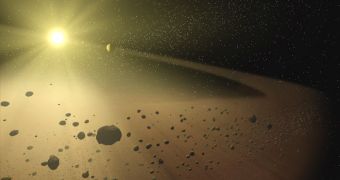The object now known as 2008 EB61 has been officially classified by the International Astronomical Union as the latest found asteroid. The discovery was made by Ryan Gallagher and Robbyn Kindle from the Forest Hill and North Richland Hills respectively, on March 9, after spotting a small feature of a unidentified space object, while double checking images of the asteroid belt, previously processed by a computer. Physics and astronomy professor Raymond Benge from TCC Northeast Campus and teacher of the two students says that "for undergraduate students to find an asteroid today is very rare." One must take into consideration that there are many astronomers around the world who never had this privilege.
According to Benge, there are more than 160,000 asteroids that have been identified so far. The two students joined the class of professor Benge last year in the hope to improve their chances of getting into a medical school. At the same time, Benge asked them to join the international program to scan space images for unidentified asteroids.
All pictures first go through an automatic scan, but it seems that the computer program executing the scan simply missed or disregarded this particular one, and was later found by Gallagher and Kindle. Although the discovery seemed at first rather unimportant, the International Astronomical Union made it look like it was a big deal.
Kindle, who is 40 now, suffered, in 2000, a quadruple organ transplant - kidney, liver, small bowel, pancreas - and still had better chances of surviving and observing an asteroid rather than finding one by herself. She is now hopping that she will be able to enter the master's program in science at the University of North Texas.
Gallagher and Kindle will have the opportunity of giving 2008 EB61 a permanent name, once astronomers establish the orbit of the asteroid. This kind of work usually takes up to three years or so; nonetheless, Kindle hopes to name it "I'm Going Blind', since at the time they discovered it, both were uncertain whether it was a real object or a pixel artifact on the computer monitor, that's how small it appeared in the image.
Even though she suffered four major operations during the course of her life, Kindle argues she can withstand yet another, this time to correct her eye vision. "I wear contacts and I'd Like to get LASIK," said Kindle.

 14 DAY TRIAL //
14 DAY TRIAL //